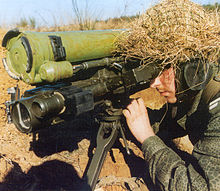Anti-tank guided missile


The anti-tank guided missile (sometimes also anti-tank guided missile - PALR, anti- armored missile or anti-tank missile ) is a missile that is used to combat tanks and is directed at the target in flight. It is to be differentiated from unguided reactive anti-tank hand weapons like the bazooka or RPG-7 .
Ground-based systems are used behind earth walls, from the edge of the forest or other hidden places, but also from vehicles. Anti-tank guided weapons can be used as air-to-ground weapons in addition to ground- to-ground use, with combat aircraft , combat helicopters and, more recently, drones serving as launch platforms.
The steerability also enables new tactics such as the "top attack" system, in which the missile moves in an arc towards the relatively weakly armored top of the tank.
Development stages and steering systems
The first systems were developed in the last few years of World War II. So far, there are three generations of steering systems:
- Passive steering systems (also MCLOS = Manual Command to Line of Sight), in which the control to the target is manual and must be maintained until the impact. In these first generation systems , control was usually carried out by a wire connection between the missile and the launch platform. It took intensive training and skill to hit the target. There were also radio-controlled versions, but they are prone to failure. An example of active steering systems is the Soviet 9M14 Maljutka , which was often used on the Egyptian side in the Middle East conflict .
- Semi-active guidance systems (also known as SACLOS ) in which the shooter only has to keep the target in his sights while the missile automatically corrects its path along the target line. Older guided missiles are controlled according to this principle via a connecting wire, while the newer systems rely on target illumination by laser , which leads to greater flexibility and safety for the shooter, as this can also be done from another location. Wire-controlled systems are, for example, the US M47 Dragon and TOW or the European HOT and MILAN and the Russian 9K115-2 Metis-M , the American AGM-114 Hellfire (except version L) and the Russian 9K135 Kornet are laser-controlled . Tube rockets have so far only had laser-controlled, semi-active steering systems.
- Active guidance systems that independently track the target through sensors (optical, infrared or radar) in the warhead. With these third-generation systems , the shooter only sets the target using a video viewfinder before take-off; line of sight during the flight or target lighting are no longer necessary - also known as fire-and-forget . The US Army currently uses the FGM-148 Javelin with infrared video search head and the L version of the AGM-114 Hellfire II, while the Russian Army recently introduced the 9K123 Chrisantema system, which alternatively uses lasers (SACLOS) - or radar (fire-and-forget) control.
